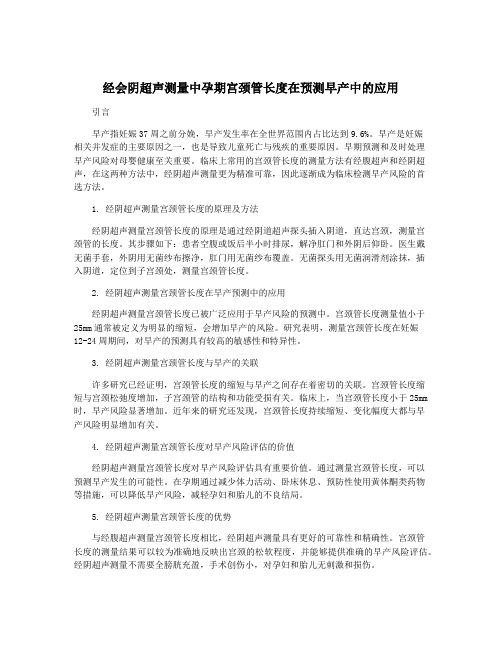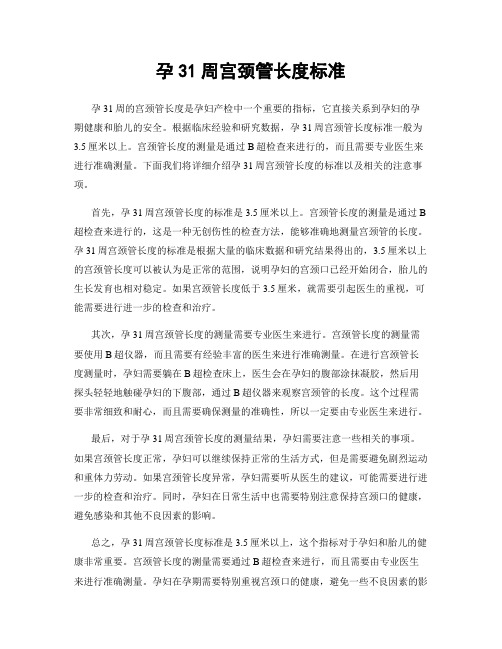测宫颈管长度
经会阴超声测量中孕期宫颈管长度在预测早产中的应用

经会阴超声测量中孕期宫颈管长度在预测早产中的应用随着现代医学技术的不断进步,产科医学在孕妇产前保健中扮演着越来越重要的角色。
早产是一种常见的并发症,尤其对胎儿和新生儿的生存和发育会产生严重影响。
早产的预测和预防就显得尤为重要。
会阴超声测量中孕期宫颈管长度是目前用于预测早产的一种有力工具。
在本文中,我们将探讨孕期宫颈管长度的测量方法和其在预测早产中的应用。
孕期宫颈长度的测量方法一般都是通过B超扫描进行的。
这种方法简单、安全,且不会对孕妇和胎儿造成伤害。
通常在孕17-24周测量宫颈长度的效果最佳,因为在这个时间段,宫颈的生理变化不大,且胎儿大小适中,辨识宫颈的解剖结构也比较容易。
测量时,孕妇需要取左侧卧位,然后医生会在会阴部施加一定的压力,并通过B超探头在会阴区测量宫颈长度。
由于测量宫颈长度时需要一定的技术经验,所以建议由有经验的医生进行操作。
孕期宫颈管长度是预测早产的一种重要指标。
一般来说,宫颈管长度过短(通常小于25mm)会增加早产的风险。
因为宫颈的主要功能是支撑子宫,当宫颈管过短时,承载力就会减弱,容易导致子宫颈口提前松弛和开放,形成宫颈无力。
宫颈管长度的测量结果还可以结合其他检查项目,如宫颈管内的分泌物、阴道炎症情况等,综合评估孕妇的早产风险。
在临床实践中,孕期宫颈管长度的预测早产的应用是非常广泛的。
可以通过宫颈长度的测量,对孕妇进行分层管理。
对于宫颈长度正常的孕妇,可以采取一般的产前检查措施;而对于宫颈长度过短(小于25mm)的孕妇,可以采取针对性的预防措施,如宫颈埋箍术、宫颈缝合术等,以减轻早产风险。
宫颈长度的测量还可以用于评估孕妇在高危早产群中的风险程度。
部分研究表明,宫颈管长度越短,早产风险越高。
可以通过宫颈长度的测量,针对性地对高危孕妇进行干预,以减少早产的发生率。
除了在预测早产中的应用外,孕期宫颈管长度的测量还可以显示孕妇的自然分娩和剖宫产的概率。
研究表明,宫颈长度较短的孕妇,自然分娩的概率会明显降低,产程延长,容易导致产程并发症。
经会阴超声测量中孕期宫颈管长度在预测早产中的应用

经会阴超声测量中孕期宫颈管长度在预测早产中的应用
经会阴超声测量是一种非侵入性的方法,可以评估孕妇宫颈管的长度和形态,常用于
预测早产的发生。
预测早产对于孕妇和胎儿的健康非常重要,及早进行干预措施可以减少
早产的风险,提高妊娠结局。
在经会阴超声测量中,医生会使用一种特殊的探头通过阴道将超声波发送到宫颈管内,通过超声图像观察宫颈管的长度和形态。
宫颈管的长度通常在孕期逐渐缩短,而早产往往
伴随着宫颈管的提前缩短。
通过测量宫颈管的长度可以预测早产的风险。
宫颈管长度的测量通常在孕妇怀孕12周到24周之间进行,这是预测早产最为准确的
时间窗口。
当宫颈管长度小于25mm时,孕妇的早产风险增加。
宫颈口的开口程度也是预测早产的重要指标,开口程度越大,早产风险越高。
根据宫颈管长度和开口程度的测量结果,医生可以评估孕妇的早产风险,并制定相应
的干预措施。
对于高风险孕妇,医生可能会建议增加监测频率,提前进行胎膜囊缝合术或
宫颈环扎等干预措施,以减少早产的发生。
孕妇也需要根据医生的建议进行必要的休息,
避免剧烈体力活动或性生活,以降低宫颈提前缩短的风险。
经会阴超声测量中孕期宫颈管长度在预测早产中具有较高的敏感性和准确性,可以提
供有效的预测指导和干预措施,对于改善孕妇和胎儿的健康具有重要意义。
预测早产并非
完全准确,仍然存在一定的误差,因此综合其他的临床指标和辅助检查结果进行综合判断
是十分必要的。
经会阴超声测量中孕期宫颈管长度在预测早产中的应用

经会阴超声测量中孕期宫颈管长度在预测早产中的应用引言早产指妊娠37周之前分娩,早产发生率在全世界范围内占比达到9.6%。
早产是妊娠相关并发症的主要原因之一,也是导致儿童死亡与残疾的重要原因。
早期预测和及时处理早产风险对母婴健康至关重要。
临床上常用的宫颈管长度的测量方法有经腹超声和经阴超声,在这两种方法中,经阴超声测量更为精准可靠,因此逐渐成为临床检测早产风险的首选方法。
1. 经阴超声测量宫颈管长度的原理及方法经阴超声测量宫颈管长度的原理是通过经阴道超声探头插入阴道,直达宫颈,测量宫颈管的长度。
其步骤如下:患者空腹或饭后半小时排尿,解净肛门和外阴后仰卧。
医生戴无菌手套,外阴用无菌纱布擦净,肛门用无菌纱布覆盖。
无菌探头用无菌润滑剂涂抹,插入阴道,定位到子宫颈处,测量宫颈管长度。
2. 经阴超声测量宫颈管长度在早产预测中的应用经阴超声测量宫颈管长度已被广泛应用于早产风险的预测中。
宫颈管长度测量值小于25mm通常被定义为明显的缩短,会增加早产的风险。
研究表明,测量宫颈管长度在妊娠12-24周期间,对早产的预测具有较高的敏感性和特异性。
3. 经阴超声测量宫颈管长度与早产的关联许多研究已经证明,宫颈管长度的缩短与早产之间存在着密切的关联。
宫颈管长度缩短与宫颈松弛度增加,子宫颈管的结构和功能受损有关。
临床上,当宫颈管长度小于25mm 时,早产风险显著增加。
近年来的研究还发现,宫颈管长度持续缩短、变化幅度大都与早产风险明显增加有关。
4. 经阴超声测量宫颈管长度对早产风险评估的价值经阴超声测量宫颈管长度对早产风险评估具有重要价值。
通过测量宫颈管长度,可以预测早产发生的可能性。
在孕期通过减少体力活动、卧床休息、预防性使用黄体酮类药物等措施,可以降低早产风险,减轻孕妇和胎儿的不良结局。
5. 经阴超声测量宫颈管长度的优势与经腹超声测量宫颈管长度相比,经阴超声测量具有更好的可靠性和精确性。
宫颈管长度的测量结果可以较为准确地反映出宫颈的松软程度,并能够提供准确的早产风险评估。
经会阴超声测量中孕期宫颈管长度在预测早产中的应用

经会阴超声测量中孕期宫颈管长度在预测早产中的应用早产是指妊娠37周之前分娩,是妊娠期的主要并发症之一。
早产儿的出生体重较低,免疫功能较弱,易发生呼吸窘迫综合征、颅内出血等并发症,对于新生儿的生存和健康状况有着重要的影响。
早期预测和干预早产对减少相应并发症的发生具有重要意义。
宫颈管长度是指从宫颈内口至外口(宫颈口)的距离,是宫颈功能状态的可靠指标。
经会阴超声测量宫颈管长度是一种无创、简便、可重复性高的方法,对于评估宫颈功能状态及预测早产的风险具有重要意义。
当孕妇处于妊娠中后期时,宫颈管会逐渐变短而增宽,直到胎儿娩出。
一些孕妇在妊娠中期时,宫颈功能异常,导致宫颈管过早缩短。
这种过早缩短的宫颈管与早产之间存在着密切的关系。
通过经会阴超声测量宫颈管长度,可以较早地发现宫颈功能异常,并进行相应的干预。
一般认为,当宫颈管长度小于25mm时,存在早产的风险。
如果孕妇在中期(16-24周)出现宫颈管长度小于25mm的情况,她们比较容易发生早产。
在中期进行宫颈管长度的测量可以帮助医生识别高早产风险的孕妇。
除了宫颈管长度的测量,还可以通过观察宫颈内口的开口程度来判断早产的风险。
一般认为,宫颈内口开口程度小于2cm时,存在早产的风险。
经会阴超声测量可以提供直观的可视化信息,帮助医生更准确地判断宫颈内口的开口程度。
通过经会阴超声测量宫颈管长度,可以及早发现高早产风险的孕妇,并采取相应的干预措施。
常用的干预措施包括宫颈埋箍、宫颈堵塞、宫颈缝合术等。
这些干预措施可以减轻宫颈压力,延长宫颈管长度,降低早产的风险。
经会阴超声测量中孕期宫颈管长度在预测早产中具有重要的应用价值。
通过测量宫颈管长度,可以及早发现早产风险,并及时采取干预措施,以降低早产的发生率,减少相应的并发症发生,提高早产儿的生存率和健康状况。
孕周宫颈管长度标准

孕周宫颈管长度标准孕周宫颈管长度(Cervical Length)是指自宫颈内口到内口之间的距离,是评估孕妇宫颈的重要指标之一。
宫颈管长度的测量常常用于孕晚期预测早产风险,通过监测宫颈管长度的变化,可以预测早产的可能性,从而进行相应的干预措施。
孕周宫颈管长度标准是指在不同孕周期间,正常孕妇宫颈管长度的变化情况。
具体的标准数值会根据研究人群、测量方法和设备的不同而有所差异,下面列举一些常见的孕周宫颈管长度标准的参考内容:1. 孕周16周:宫颈管长度大多数情况下在25-35毫米之间。
2. 孕周20周:宫颈管长度大多数情况下在25-35毫米之间。
3. 孕周24周:宫颈管长度大多数情况下在25-35毫米之间。
4. 孕周28周:宫颈管长度大多数情况下在25-35毫米之间。
5. 孕周32周:宫颈管长度大多数情况下在25-35毫米之间。
6. 孕周36周:宫颈管长度大多数情况下在25-35毫米之间。
7. 孕周40周:宫颈管长度大多数情况下在25-35毫米之间。
需要注意的是,宫颈管长度标准可能会因个体差异、孕妇体位、子宫活动等因素而有所变化。
因此,确定一个准确的宫颈管长度正常范围是相当困难的,而且在不同的研究中也存在一定的差异。
除了宫颈管长度的数值范围,还有一些研究关注宫颈管长度的变化趋势。
例如,一项研究指出,孕周19周和孕周24周之间的宫颈管长度变化可能与早产的风险相关。
如果在这个阶段,孕妇的宫颈管长度较短或较长,可能会增加早产的风险。
此外,孕周宫颈管长度标准还与子宫骨盆形态有关。
例如,对于具有骨盆变形的孕妇,他们的宫颈管长度可能会有所不同。
因此,在评估宫颈管长度时,还需要考虑孕妇的骨盆形态或相关的先天性异常。
综上所述,孕周宫颈管长度标准是一个相对的范围参考,不同的研究可能存在一定的差异。
在临床实践中,如果孕妇的宫颈管长度较短或出现异常变化,应及时进行进一步的评估和管理,以减少早产的风险。
对于个别孕妇,可能需要进行更频繁的宫颈管长度监测,并采取相应的干预措施,以确保胎儿的健康发育。
孕38周宫颈管长度标准

孕38周宫颈管长度标准孕38周的宫颈管长度是孕期检查中的一个重要指标,它可以反映出孕妇的宫颈状态和孕期的健康状况。
宫颈管长度的测量对于孕妇和胎儿的健康至关重要,下面我们来详细了解一下孕38周宫颈管长度的标准。
在孕期检查中,医生通常会通过B超来测量孕妇的宫颈管长度。
正常情况下,孕38周的宫颈管长度应该在3.0厘米以上,这是一个比较理想的宫颈状态。
宫颈管长度的正常范围为3.0厘米至5.0厘米,如果宫颈管长度小于3.0厘米,可能会提示宫颈功能不全的风险,需要引起重视。
宫颈功能不全是指宫颈在孕期缺乏足够的支撑力,容易发生宫颈松弛,导致早产的风险增加。
因此,对于宫颈功能不全的孕妇,医生可能会建议进行宫颈埋箍术或者宫颈埋箍环的手术治疗,以增加宫颈的支撑力,减少早产的风险。
此外,孕38周的宫颈管长度也可以反映出孕妇的生活方式和保健习惯。
孕妇在孕期应该注意避免长时间站立、过度劳累和剧烈运动,尤其是孕晚期,更应该多休息,保持心情舒畅,避免情绪波动。
合理的饮食和作息也对宫颈管长度有一定的影响,建议孕妇多摄入富含蛋白质、维生素和矿物质的食物,保持规律的作息时间,有助于维持宫颈的健康状态。
在孕期的日常生活中,孕妇还应该避免性生活和阴道检查等行为,以免刺激宫颈,增加宫颈松弛的风险。
此外,孕妇还应该定期进行产前检查,及时了解自己和胎儿的健康状况,对于宫颈管长度异常的情况,及时采取相应的治疗措施,以确保母婴的健康。
总之,孕38周的宫颈管长度是孕期检查中的重要指标之一,它可以反映出孕妇的宫颈状态和孕期的健康状况。
通过定期的产前检查和科学的生活方式,孕妇可以有效地维护宫颈的健康,减少早产的风险,保障母婴的健康。
希望每一位准妈妈都能度过一个健康愉快的孕期,迎接宝宝的到来。
经会阴超声测量中孕期宫颈管长度在预测早产中的应用

经会阴超声测量中孕期宫颈管长度在预测早产中的应用早产是指胎儿在妊娠期37周之前出生。
早产是婴儿死亡和儿童发育障碍的主要原因之一,因此预测早产非常重要。
经会阴超声测量孕期宫颈管长度是一种常用的方法,可以用来预测早产风险,提供早期干预和管理措施。
宫颈管是连接子宫和阴道的通道,宫颈管长度的测量可以提供对宫颈强度和稳定性的信息。
通常情况下,宫颈在妊娠期应该是紧闭的状态,但一些因素(如宫颈松弛,宫颈炎症等)可能导致宫颈过早开放,增加早产风险。
经会阴超声可以通过测量宫颈管长度来评估宫颈的状态。
经会阴超声测量宫颈管长度的方法相对简单,通常在妊娠中后期进行。
医生会使用阴道探头将超声探测器插入阴道,然后通过超声波测量宫颈管长度。
正常宫颈管长度通常在30-40毫米之间,而缩短的宫颈管长度通常被认为是早产的一个危险因素。
根据研究,宫颈管长度在预测早产中具有一定的预测价值。
宫颈管长度小于25毫米与早产的风险增加相关。
临床研究还发现,宫颈管长度与其他早产预测指标(如宫颈粘液检查和宫颈短缩指数)的结合使用可以提高预测准确性。
通过经会阴超声测量宫颈管长度可以帮助医生识别早产风险增加的孕妇,并采取相应的管理措施。
对于宫颈管长度缩短的孕妇,医生可能会建议进行宫颈环扎术,即在宫颈上部缝制一圈线,以增加宫颈的稳定性。
医生还可以根据宫颈管长度进行更加密切的监测和随访,早发现和早处理可能存在的早产迹象。
尽管经会阴超声测量宫颈管长度在预测早产中有一定的价值,但其危险性预测能力仍然是有限的。
宫颈管长度的测量结果应结合其他因素进行评估,并在临床上谨慎应用,以减少误诊率。
经会阴超声测量孕期宫颈管长度是一种常用且可靠的方法,可以帮助预测早产风险并提供相应的管理措施。
其预测准确性仍需进一步研究和验证,以提高早产预测的准确性和有效性。
孕31周宫颈管长度标准

孕31周宫颈管长度标准孕31周的宫颈管长度是孕妇产检中一个重要的指标,它直接关系到孕妇的孕期健康和胎儿的安全。
根据临床经验和研究数据,孕31周宫颈管长度标准一般为3.5厘米以上。
宫颈管长度的测量是通过B超检查来进行的,而且需要专业医生来进行准确测量。
下面我们将详细介绍孕31周宫颈管长度的标准以及相关的注意事项。
首先,孕31周宫颈管长度的标准是3.5厘米以上。
宫颈管长度的测量是通过B 超检查来进行的,这是一种无创伤性的检查方法,能够准确地测量宫颈管的长度。
孕31周宫颈管长度的标准是根据大量的临床数据和研究结果得出的,3.5厘米以上的宫颈管长度可以被认为是正常的范围,说明孕妇的宫颈口已经开始闭合,胎儿的生长发育也相对稳定。
如果宫颈管长度低于3.5厘米,就需要引起医生的重视,可能需要进行进一步的检查和治疗。
其次,孕31周宫颈管长度的测量需要专业医生来进行。
宫颈管长度的测量需要使用B超仪器,而且需要有经验丰富的医生来进行准确测量。
在进行宫颈管长度测量时,孕妇需要躺在B超检查床上,医生会在孕妇的腹部涂抹凝胶,然后用探头轻轻地触碰孕妇的下腹部,通过B超仪器来观察宫颈管的长度。
这个过程需要非常细致和耐心,而且需要确保测量的准确性,所以一定要由专业医生来进行。
最后,对于孕31周宫颈管长度的测量结果,孕妇需要注意一些相关的事项。
如果宫颈管长度正常,孕妇可以继续保持正常的生活方式,但是需要避免剧烈运动和重体力劳动。
如果宫颈管长度异常,孕妇需要听从医生的建议,可能需要进行进一步的检查和治疗。
同时,孕妇在日常生活中也需要特别注意保持宫颈口的健康,避免感染和其他不良因素的影响。
总之,孕31周宫颈管长度标准是3.5厘米以上,这个指标对于孕妇和胎儿的健康非常重要。
宫颈管长度的测量需要通过B超检查来进行,而且需要由专业医生来进行准确测量。
孕妇在孕期需要特别重视宫颈口的健康,避免一些不良因素的影响,保障自己和胎儿的健康。
希望每一位孕妇都能够度过一个健康愉快的孕期,迎接新生命的到来。
经会阴超声测量中孕期宫颈管长度在预测先兆早产中的临床应用

经会阴超声测量中孕期宫颈管长度在预测先兆早产中的临床应用引言孕期宫颈管长度是评估孕妇是否存在先兆早产的重要指标之一。
通过经会阴超声测量宫颈管长度,可以及时发现宫颈功能异常,早期预测和干预先兆早产,降低早产率,保护母婴健康。
本文针对经会阴超声测量中孕期宫颈管长度在预测先兆早产中的临床应用进行深入探讨,以期为临床医生提供更科学的诊断和治疗方法。
一、宫颈管长度与先兆早产的关系1. 宫颈管长度测量方法宫颈管长度的测量通常采用经会阴超声进行,包括宫颈内口以上、宫颈管中部和宫颈口下的三个部位。
测量时应选择子宫颈管纵切位,测量孕妇已排尿并处于平卧位时的宫颈管长度。
2. 宫颈管长度与早产的关系临床研究表明,宫颈管长度的缩短与先兆早产之间存在着密切的关系。
在孕期,宫颈管长度缩短超过25mm,尤其是宫颈内口以上的长度缩短至15mm以下时,提示孕妇存在先兆早产的危险。
3. 宫颈管长度的变化宫颈管长度不仅受孕周的影响,还受多种因素的影响,包括孕妇个体差异、子宫和宫颈功能异常、感染等因素。
经会阴超声测量宫颈管长度不仅可以及时发现宫颈功能异常,还可以及时发现潜在的先兆早产的风险。
2. 助力早产风险评估通过宫颈管长度的测量,可辅助医生进行早产风险的评估,及时采取相应措施,如卧床休息、使用宫颈埋箍环等治疗措施,减少孕妇和胎儿的风险。
3. 指导临床治疗策略宫颈管长度的测量结果可以指导临床医生确定治疗策略,包括孕妇的卧床休息、服用宫颈松弛剂、使用宫颈埋箍环等,有针对性地针对不同的宫颈功能异常进行干预,提高治疗的有效性。
4. 监测治疗效果经会阴超声测量宫颈管长度可以定期监测治疗效果,及时调整治疗方案,确保孕妇的安全和胎儿的健康。
三、注意事项1. 宫颈管长度测量应在孕周16-24周进行,此时为预测先兆早产的最佳时间窗口。
2. 测量过程中要注意避免孕妇过度憋尿,影响宫颈管长度的准确测量。
3. 宫颈管长度的测量结果应结合孕妇的病史、临床症状和其他辅助检查结果进行综合分析,不可片面依靠宫颈管长度的结果作出诊断和治疗决策。
经会阴超声测量中孕期宫颈管长度在预测早产中的应用

经会阴超声测量中孕期宫颈管长度在预测早产中的应用1. 引言1.1 研究背景早产是指孕周37周之前发生的分娩,是围产医学中的一种常见并发症,危害儿童健康。
早产可能导致新生儿死亡、神经系统障碍等多种并发症。
对早产进行有效的预测和干预显得尤为重要。
宫颈管长度是指宫颈内口到宫腔口之间的直线距离,宫颈管长度的改变与早产之间存在一定的相关性。
随着技术的发展,经会阴超声测量宫颈管长度成为一种常见的方法。
经会阴超声检查简便、无创伤,可以清晰地显示宫颈及其周围结构,为宫颈管长度的测量提供了方便条件。
近年来,越来越多的研究表明,经会阴超声测量宫颈管长度在预测早产中具有一定的应用价值。
宫颈管长度短、宫颈内口开放、宫颈管长度缩短速度加快等因素都提示着早产的风险增加。
通过对孕期宫颈管长度的监测和评估,可以为早产的预测和干预提供重要依据。
本文将探讨经会阴超声测量在预测早产中的应用,分析影响宫颈管长度的因素,探讨宫颈管长度与早产的相关性,探讨经会阴超声测量在预测早产中的临床意义和应用前景。
希望通过本文的研究能够提供新的思路和方法,为早产的预防和管理提供更有效的手段。
2. 正文2.1 孕期宫颈管长度的测量方法孕期宫颈管长度的测量方法是通过经会阴超声进行测量。
这是一种无创伤的方法,可以在孕妇躺在检查床上时进行。
医生会要求孕妇膀胱充盈,以提高超声图像的清晰度。
然后,医生会插入一个适当大小的探头到阴道中,使其紧贴宫颈测量点。
接着,医生通过超声波来测量宫颈管的长度,通常是从内口到外口的距离。
这个过程通常只需要几分钟,孕妇感觉到的是一点点的压力。
在测量过程中,医生会注意观察宫颈的形态、内口的长度和宽度、以及宫颈管的内部结构。
这些参数都可以用来评估孕妇的早产风险。
通过经会阴超声测量,医生可以提前发现宫颈管长度的异常变化,从而及时干预并降低早产的风险。
这种测量方法具有简便、准确、可重复性高的特点,因此被广泛应用于临床实践中。
通过及时监测和评估孕妇的宫颈管长度,可以有效预防早产并保障母婴的健康。
宫颈管长度标准参考

宫颈管长度标准参考
宫颈管长度是指宫颈内口至宫腔内口的距离,是评估宫颈功能和孕妇产科疾病
的重要指标。
宫颈管长度的测量对于孕妇的产前评估和产科疾病的诊断具有重要意义。
下面将介绍宫颈管长度的标准参考范围,以便临床医生和孕妇对其进行参考。
宫颈管长度的标准参考范围为2.5-4.5厘米。
在孕早期,宫颈管长度可以通过B 超检查来测量。
正常情况下,宫颈管长度在20周以前应保持在3.0-4.5厘米之间。
如果宫颈管长度小于2.5厘米,可能会增加早产的风险。
因此,孕妇在孕早期应定
期进行产前检查,以确保宫颈管长度在正常范围内。
宫颈管长度的测量方法有多种,包括经阴道超声、经腹超声和临床检查。
其中,经阴道超声是目前最常用的测量方法,因为它可以更准确地测量宫颈管长度,对于早产的预测和预防更加有效。
除了孕妇产前评估外,宫颈管长度的测量对于宫颈疾病的诊断和治疗也有重要
意义。
宫颈管长度的缩短可能是宫颈功能不全的表现,这种情况下孕妇需要特别注意休息,避免性生活和剧烈运动,以减少早产的风险。
对于宫颈疾病的治疗,如宫颈松弛、宫颈炎症等,宫颈管长度的测量可以帮助医生制定更有效的治疗方案。
总之,宫颈管长度是评估宫颈功能和孕妇产科疾病的重要指标,其标准参考范
围为2.5-4.5厘米。
孕妇应在孕早期进行宫颈管长度的定期检查,以确保其在正常
范围内,减少早产的风险。
对于宫颈疾病的诊断和治疗,宫颈管长度的测量也具有重要意义。
因此,医生和孕妇应重视宫颈管长度的测量,及时采取措施,保障母婴健康。
孕37周宫颈管长度标准

孕37周宫颈管长度标准孕37周宫颈管长度是指孕妇怀孕37周时子宫颈内口至宫颈外口的长度。
宫颈管长度对于孕妇来说是一个重要的指标,它直接关系到孕妇的孕期健康和分娩情况。
正常的宫颈管长度能够为胎儿提供一个稳定的生长环境,同时也能够减少早产的风险。
因此,了解孕37周宫颈管长度的标准对于孕妇来说是非常重要的。
在孕37周,正常的宫颈管长度应该在3.5厘米到4.5厘米之间。
如果宫颈管长度小于3.5厘米,可能会增加早产的风险;如果宫颈管长度大于4.5厘米,可能会增加产程延长的风险。
因此,孕妇在孕37周时应该定期进行产检,以确保宫颈管长度在正常范围内。
孕37周宫颈管长度的测量通常是通过B超来进行的。
在B超检查中,医生会使用阴道探头来测量宫颈管长度。
这个过程通常是安全和无痛的,但有时候可能会引起孕妇的轻微不适。
因此,在进行宫颈管长度测量前,孕妇应该向医生了解清楚整个过程,以及可能的不适反应。
除了宫颈管长度的测量,孕37周的产检还包括其他内容,比如胎心监测、羊水指数检查等。
这些检查都是为了确保母婴的健康,孕妇应该积极配合医生的检查和建议,以确保自己和胎儿的安全。
在孕37周时,孕妇还需要注意自己的日常生活。
比如,要保持良好的作息习惯,避免过度劳累和情绪波动;要注意饮食营养的均衡,多摄入富含蛋白质、维生素和矿物质的食物;要避免接触有害物质,比如化学品和辐射等。
这些都是为了保证孕妇和胎儿的健康,孕妇应该认真对待自己的日常生活。
总之,孕37周宫颈管长度的标准对于孕妇来说是非常重要的。
孕妇应该定期进行产检,确保宫颈管长度在正常范围内;同时,孕妇还需要注意自己的日常生活,保证自己和胎儿的健康。
希望每一位孕妇都能顺利度过孕期,迎接健康宝宝的到来。
孕30周宫颈管长度标准

孕30周宫颈管长度标准孕30周宫颈管长度是孕妇产检中的一个重要指标,它能够反映孕妇宫颈的健康状况,对孕妇和胎儿的健康都有重要的影响。
宫颈管长度的变化可能会影响孕妇的妊娠结局,因此了解孕30周宫颈管长度的标准对于孕妇的产检非常重要。
在孕30周,宫颈管长度的正常范围一般在3.0厘米到4.5厘米之间。
如果宫颈管长度小于3.0厘米,可能会增加孕妇早产的风险;如果宫颈管长度大于4.5厘米,可能会增加孕妇宫颈松弛的风险。
因此,孕30周宫颈管长度的标准范围是非常重要的,它可以帮助医生及时评估孕妇的宫颈健康状况,采取相应的干预措施,降低孕妇早产的风险。
孕30周宫颈管长度的检测方法一般是通过B超检查来进行的。
在检查过程中,孕妇需要躺在检查床上,医生会在孕妇的腹部涂上适量的凝胶,然后用探头轻轻地贴近孕妇的腹部,通过B超图像来观察宫颈管的长度。
这个过程通常是无痛的,也不会对孕妇和胎儿造成任何伤害。
除了宫颈管长度,孕30周的产检还包括其他指标的检测,比如羊水指数、胎儿的发育情况等。
这些指标的综合评估可以帮助医生全面地了解孕妇和胎儿的健康状况,及时发现并处理可能存在的问题,保障母婴的健康。
对于孕30周宫颈管长度不在标准范围内的孕妇,医生可能会采取一些干预措施,比如建议孕妇适当休息,避免剧烈运动,避免长时间站立等;或者给予一些药物治疗,比如黄体酮等。
在一些严重的情况下,医生可能还会建议孕妇住院休息,或者进行宫颈埋箍手术等。
总之,孕30周宫颈管长度的标准范围是非常重要的,它可以帮助医生及时评估孕妇的宫颈健康状况,采取相应的干预措施,降低孕妇早产的风险。
孕妇在孕期要注意定期进行产检,关注宫颈管长度的变化,及时发现并处理可能存在的问题,保障母婴的健康。
希望每一位孕妇都能顺利度过孕期,迎接健康宝宝的到来。
经会阴超声测量中孕期宫颈管长度在预测早产中的应用

经会阴超声测量中孕期宫颈管长度在预测早产中的应用一、孕期宫颈管长度对早产的影响在孕期,宫颈管长度是衡量宫颈结构和功能的关键指标之一。
正常情况下,宫颈管是闭合的,保护着子宫内的胎儿,防止外界病菌感染。
而当宫颈管长度过短时,会增加早产的风险。
孕期宫颈管长度的测量对于判断早产风险具有重要意义。
经会阴超声测量是通过经会阴途径进行的一种无创伤性检查方法,可以清晰地观察到宫颈管的结构和长度。
相比于经腹超声测量,经会阴超声测量更为舒适和准确,可以减少患者的不适感。
越来越多的医院开始采用经会阴超声测量来检查孕期宫颈管长度。
经会阴超声测量孕期宫颈管长度的方法是通过将超声探头插入阴道,直接观察和测量宫颈管的长度。
通过实时超声成像技术,医生可以清晰地看到宫颈管的状态,并及时发现异常情况。
这种方法操作简单,无创伤,可以多次检查,因此备受孕妇和医生的青睐。
许多研究表明,孕期宫颈管长度和早产之间存在着密切的关联。
宫颈管长度的缩短是早产的重要预测指标之一。
通过经会阴超声测量,医生可以及时发现宫颈管长度的异常情况,从而采取相应的预防措施。
一些研究还表明,孕期宫颈管长度的测量结果可以准确预测早产的风险程度,为医生制定个性化的产前护理方案提供了重要依据。
经会阴超声测量孕期宫颈管长度在预测早产中的应用具有一定的优势和价值。
这种方法能够及时准确地发现宫颈管长度的异常情况,为早产的预防提供了有力的支持。
经会阴超声测量方法操作简单、舒适,不会对孕妇和胎儿造成任何伤害。
宫颈管长度的测量结果可以提供重要的临床参考价值,有助于医生对孕妇进行个性化的产前管理。
经会阴超声测量孕期宫颈管长度也有助于孕妇了解自己的身体状况,增强对早产的风险意识。
通过定期检查宫颈管长度,孕妇可以及时采取相应的保健措施,减少早产的发生风险。
经会阴超声测量孕期宫颈管长度在预测早产中的应用具有重要的临床意义。
经会阴超声测量中孕期宫颈管长度在预测早产中的应用

经会阴超声测量中孕期宫颈管长度在预测早产中的应用作为孕妇的主要监测指标之一,宫颈管长度在预测早产方面具有重要的应用。
会阴超声是一种非侵入性的检查方法,可以精确测量宫颈管长度,因此被广泛应用于孕期的临床实践中。
本文将介绍宫颈管长度的相关知识和会阴超声在预测早产中的应用。
一、宫颈管的基本结构和生理变化宫颈是连接子宫和阴道的狭窄部分,由坚韧的结缔组织和肌肉组成。
宫颈管长度在孕前约为3-4厘米,孕期随着子宫的增大而逐渐变短。
在妊娠初期,宫颈管长度可以达到4-5厘米,到了孕中期则由于子宫体的挤压逐渐缩短至2-3厘米,最终在分娩时缩短至1-2厘米。
宫颈管在孕期的另一个主要生理变化是宫颈口的开张程度。
在孕期前期,宫颈口一般处于紧闭状态,而在孕晚期则逐渐松弛开放,以便于胎儿顺利通过产道。
早产是指孕期小于37周的分娩,常常发生于孕期28周之前。
早产对胎儿的健康发展有严重的威胁,包括低出生体重、呼吸窘迫、脑损伤等。
因此,在孕期对早产进行有效的监测和预测非常重要。
宫颈管长度是目前临床上最常用的早产预测指标之一。
在妊娠早期,宫颈管长度可以为早产的预测提供重要的信息。
研究表明,宫颈管长度缩短至小于25毫米时,早产的发生率将大大增加,提示孕妇需要进一步进行治疗和监测。
此外,宫颈口的开张程度也是预测早产的重要指标之一。
当宫颈口开张至1.5厘米以上时,早产的可能性也将明显增加。
会阴超声是一种非侵入性的检查方法,利用超声波进行呈像,可以精确测量宫颈管长度。
会阴超声检查可以在妊娠初期以及孕中期进行。
在孕早期,通过会阴超声检查可以确定宫颈管的初始长度,评估早产的风险。
在孕中期,会阴超声可以反复测量宫颈管长度和口型的变化,精确预测早产的发生。
会阴超声检查需要有经验的医护人员进行,且需要使用高分辨率的超声仪器。
在检查过程中,患者需要躺在背部,将脚架于床上,医生使用阴道探头进行检查。
如需进行多次检查,需要注意避免影响孕妇的正常生活和活动。
经会阴超声测量中孕期宫颈管长度在预测先兆早产中的临床应用

经会阴超声测量中孕期宫颈管长度在预测先兆早产中的临床应用随着现代医学技术的不断发展,越来越多的产前筛查工具得到了广泛的应用,其中包括经会阴超声测量中孕期宫颈管长度。
这一检查方法可以帮助医生预测孕妇是否存在先兆早产的风险,从而及时采取预防措施,保护母婴健康。
本文将探讨孕期宫颈管长度在预测先兆早产中的临床应用,并分析其在临床实践中的意义和价值。
1. 孕期宫颈管长度的重要性宫颈是连接子宫和阴道的通道,孕期宫颈管长度的变化与早产风险密切相关。
正常情况下,孕妇宫颈管长度在20-30毫米之间,但如果宫颈管长度缩短,会增加孕妇发生早产的可能性。
孕期宫颈管长度的测量成为早产风险评估的重要指标之一。
2. 经会阴超声测量中孕期宫颈管长度的特点经会阴超声是一种非侵入性、无痛苦的检查方法,特别适合孕妇群体。
通过经会阴超声测量孕期宫颈管长度,可以清晰地观察宫颈管的形态和长度,从而及时发现异常情况。
相比传统的腹部超声检查,经会阴超声对宫颈管长度的测量更加准确可靠,因此在预测先兆早产中具有独特的优势。
3. 孕期宫颈管长度在预测先兆早产中的临床应用经会阴超声测量中孕期宫颈管长度在临床上主要用于早产风险的筛查和评估。
通过及时监测宫颈管长度的变化,医生可以提前发现孕妇是否存在早产的风险,并采取相应的干预措施。
宫颈管长度的测量还可以帮助医生判断早产的可能时间,为临床决策提供重要参考依据,有助于制定合理的分娩计划和护理方案。
5. 经会阴超声测量中孕期宫颈管长度的发展趋势随着超声技术的不断进步和临床经验的积累,经会阴超声测量中孕期宫颈管长度在预测先兆早产中的应用将会越来越广泛。
未来,预计会进一步完善检查技术和标准,提高测量的精准度和可靠性。
也会加强对临床医生和产科护士的培训,提高他们对宫颈管长度监测的认识和技能,从而更好地开展产前保健工作。
6. 结语经会阴超声测量中孕期宫颈管长度在预测先兆早产中具有重要的临床应用价值,可以帮助医生及时发现孕妇的早产风险,采取有效的预防和保健措施,保护母婴健康。
孕30周宫颈管长度标准

孕30周宫颈管长度标准孕30周宫颈管长度是孕期检查中的重要指标之一,它对孕妇及胎儿的健康状况具有重要的参考价值。
正常的宫颈管长度可以为孕妇提供保护,避免早产等不良结果的发生。
下面我们将详细介绍孕30周宫颈管长度的标准,以及对其进行测量和评估的重要性。
1. 孕30周宫颈管长度的标准。
在孕30周,正常宫颈管长度应该在3.0厘米至4.0厘米之间。
如果宫颈管长度小于3.0厘米,可能表明孕妇存在宫颈功能不全的风险,增加了早产的可能性。
而如果宫颈管长度大于4.0厘米,也可能意味着存在其他潜在的问题,需要进一步的检查和评估。
2. 测量孕30周宫颈管长度的方法。
测量孕30周宫颈管长度通常通过B超来实现。
医生会使用阴道探头进行检查,这是一种无创的方法,不会对孕妇和胎儿造成任何伤害。
在测量过程中,医生会关注宫颈口的开放程度、宫颈管的长度和宫颈内口的形态,以便及时发现潜在的问题。
3. 评估孕30周宫颈管长度的重要性。
孕30周宫颈管长度的评估对孕妇和胎儿的健康至关重要。
通过及时的测量和评估,可以帮助医生发现潜在的宫颈功能不全等问题,及时采取必要的措施,减少早产的风险。
此外,对宫颈管长度的评估还可以为孕妇提供更加全面的产前保健指导,帮助她们更好地度过孕期。
4. 注意事项。
在进行孕30周宫颈管长度的评估时,孕妇需要注意以下几点:在医生的指导下进行检查,避免自行进行宫颈管长度的测量;在孕期注意休息,避免长时间站立和过度劳累;定期进行产前检查,及时发现和处理潜在的问题。
总结,孕30周宫颈管长度的评估对孕妇和胎儿的健康至关重要。
通过及时的测量和评估,可以帮助医生发现潜在的问题,减少早产的风险,为孕妇提供更加全面的产前保健指导。
在进行评估时,孕妇需要遵循医生的指导,并注意日常的休息和保健。
希望每一位孕妇都能度过一个健康、快乐的孕期。
经会阴超声测量中孕期宫颈管长度在预测早产中的应用

经会阴超声测量中孕期宫颈管长度在预测早产中的应用随着现代医疗技术的发展,人们对于孕期及其相关风险的关注也越来越多。
早产在孕期中是一种常见的并发症,临床上早期预测早产,对于孕妇及胎儿健康都具有非常重要的意义。
而宫颈管长度的测量近年来成为了预测早产的重要手段之一,本文将从经会阴超声测量中孕期宫颈管长度在预测早产中的应用这一主题出发,探讨其相关内容。
经会阴超声测量宫颈管长度是一种无痛、无损伤、简单可靠的测量方法。
传统的经腹超声测量方法虽然也能够测量到宫颈长度,但其疼痛感较明显,而且由于其需要经过腹壁、子宫等组织层层传导,对宫颈长度的估计会有一定的误差。
而经会阴超声测量法能够直接通过阴道获取宫颈长度,可以减少误差的产生。
此外,经会阴超声测量还具有不影响孕妇及胎儿健康的优点。
二、宫颈管长度与早产早产是一种孕妇及胎儿健康的重要风险,而宫颈管的长度与早产之间存在着一定的关联。
一般来说,宫颈管的长度在孕早期就已经定型了,因此孕期宫颈管长度的变化较小,仅为正常宫颈管长度的1/4-1/5。
但是,当宫颈管长度缩短到预定的阈值以下时,就会对早孕有一定风险。
经过统计分析,孕期宫颈管长度在2.5厘米以下的妇女出现早产的概率明显高于宫颈长度在3.5厘米以上的妇女。
四、宫颈管长度的监测和干预在孕期中,宫颈管长度的变化需要进行连续的监测,以便及时发现并干预早产风险。
如果宫颈管长度在孕期中出现了持续缩短的情况,那么就需要对其进行干预。
目前,临床上常用的干预措施主要是负压引流术(造口术)和宫颈环扎术。
前者是将子宫颈口周围的分泌物吸出,以减少病原菌的滋生,从而降低早产风险。
而后者则是将一个环形的物质绕在宫颈上紧缩,以延长胎儿的呆在子宫内的时间。
这两种干预措施的应用要根据个人情况而定。
综上所述,经会阴超声测量宫颈管长度在早产预测中具有重要的应用价值,并能为早产干预提供可靠的参考依据。
但是,孕期宫颈管长度的变化受到多种因素的影响,因此,对宫颈管长度进行监测和干预时需要专业医生的指导。
孕妇宫颈管分离标准

孕妇宫颈管分离标准
孕妇宫颈管分离是指宫颈管与子宫连接处的结构松弛或断裂,可能导致早产或流产的发生。
目前没有明确的宫颈管分离标准,但以下因素可能与宫颈管分离相关:
1. 宫颈管测量长度:通常来说,孕妇宫颈管的长度(测量自宫颈外口至子宫下段)在正常情况下应该超过
2.5厘米。
如果宫
颈管长度低于这一标准,可能增加宫颈管分离的风险。
2. 宫颈管松弛:孕妇在怀孕期间,宫颈管的松弛是正常的生理反应,为分娩做准备。
然而,如果宫颈管过度松弛,可能会增加宫颈管分离的风险。
3. 孕妇的症状:宫颈管分离可能伴随一些症状,如持续性的阴道出血、腹痛、腰痛、宫缩等。
这些症状可能提示宫颈管分离的可能性。
如果怀疑宫颈管分离,应及时就医,由专业医生进行检查和诊断。
医生可能会进行宫颈口扩张检查,观察宫颈松弛程度,并进行超声检查以评估宫颈长度和宫颈口的开口情况。
医生还可能会结合症状和临床表现来确定是否存在宫颈管分离。
需要注意的是,以上标准和诊断方法仅供参考,具体情况需要根据孕妇的个体情况和医生的判断来决定。
如果怀疑宫颈管分离,请及时就医寻求专业意见。
- 1、下载文档前请自行甄别文档内容的完整性,平台不提供额外的编辑、内容补充、找答案等附加服务。
- 2、"仅部分预览"的文档,不可在线预览部分如存在完整性等问题,可反馈申请退款(可完整预览的文档不适用该条件!)。
- 3、如文档侵犯您的权益,请联系客服反馈,我们会尽快为您处理(人工客服工作时间:9:00-18:30)。
The cervical canal may have a thin layer of hypoechoic contents. This is especially true in the third trimester. In all likelihood, this represents accumulation of mucus. This finding needs to be differentiated from a thin cervical funnel. This is best done by delineating the course of the fetal membranes: if they are not prolapsing into the cervical canal and are located at the level of the internal cervical os, the presence of a true funnel is unlikely.
Funneling, defined as protrusion of the amniotic membranes into the cervical canal, is considered by some as an additional risk factor of preterm delivery. Various criteria for the diagnosis of true funneling have been published. However, using a logistic regression analysis that includes both funneling and cervical length, funneling has been shown not to be an independent risk factor.
Ideal maternal position: dorsal lithotomy
Videoclip S1: Normal.avi
The cervix should be measured along its longitudinal axis. The cervix should occupy approximately 50–75% of the image. Excessive pressure on the cervix by the probe should be avoided, as the cervix artificially appears to be longer and the presence of a funnel will be obscured. The examination should last for 3–5min. Several (at least three) measurements should be obtained during the course of the examination and the shortest measurement should be used for counseling.
This is particularly important when measuring the cervical length in the first trimester.
Videoclip S2: Ex_pressure.avi
Excessive pressure on the cervix by the probe should be avoided, as the cervix artificially appears to be longer and the presence of a funnel will be obscured.
Videoclip S3: Dyn_cervix.mov
The cervix is not a static structure and the length can vary, for example due to uterine contractions or a different position of the patient. Therefore, sufficient time should be allowed for the examination to detect these changes. It may be helpful to manually press on the uterus or to ask the patient to push downwards to assess the cervical stability. Some even suggest that the patient stands up during the examination, with the ultrasound probe inside the vagina.
How to measure cervical length
Karl Oliver Kagan and Jiri Sonek
How to:
measure the cervical length
Indication: routine pregnancy care and for patients with
an increased risk of preterm delivery
When?
At 20–24 weeks’ gestation and anytime in patients with an increased risk of preterm delivery (11–13 weeks)
Ultrasound approach: transvaginal or transperineal
27mm Full bladder Empty bladder
14mm
A full bladder can artificially increase the cervical length. To et al. showed that mean difference between the cervical length measured with an empty and full bladder is about 4mm. In addition, a full bladder can obscure the presence of cervical funneling by compressing the two halves of the funnel together.
Care should be taken to identify vasa previa (left), placenta previa (right), or a low-lying placenta.
In general, the cervix should be assessed transvaginally. In cases where transvaginal ultrasound should be avoided, such as premature rupture of membranes, the cervical length can be measured by a transperineal approach. The transabdominal assessment of the cervical length can be used as an initial evaluation but a proper risபைடு நூலகம் assessment should be based on a transvaginal or transperineal measurement.
Videoclip S4: Sludge.avi
Amniotic fluid sludge can be found as echogenic aggregates close to the internal os or within a funnel. This appears to be associated with microbial invasion of the amniotic cavity. Sludge is an independent risk factor for spontaneous preterm delivery, preterm premature rupture of membranes, microbial invasion of the amniotic cavity and histological chorioamnionitis in asymptomatic patients at high risk for spontaneous preterm delivery.
The cervical canal and the surrounding cervical mucosa need to be identified. In order to avoid inclusion of the isthmus into the cervical length measurement, care must be taken to identify the internal, as well as the cervical, os. The external cervical os is identified as the point where the anterior and posterior lips of the cervix come together. The identification of the internal cervical os can be more challenging. Identification of the cervical mucosa as a homogenous and hypoechoic structure, compared to the surrounding stroma, can be helpful in these cases, as the internal cervical os is located at the point where the cervical mucosa ends.
